Dynamic Effects of Management Support on Knowledge-Based Competitiveness in Construction Companies
Abstract
1. Introduction
- Does management support influence KM implementation and KBC enhancement, specifically through budget allocation?
- How can KBC be enhanced through KM implementation in the short and long term?
2. Literature Review
3. Methodology
3.1. Research Flow
3.2. Conceptual Framework of KBC Enhancement
3.3. Scoring System of the Conceptual Framework
3.4. SD Modeling Approach
3.5. The SD Model of KBC Enhancement
4. Results
4.1. Simulation Results
4.2. Scenario Analysis
4.2.1. Budget Allocation Scenario
4.2.2. Short- and Long-Term Plan Scenario
5. Discussion
6. Conclusions
- Management support, through budget allocation, has an important role in KBC enhancement (Hypothesis 1).
- Short- and long-term strategies to enhance KBC can be set through KM implementation, focusing on human-centered activities (i.e., activities in the KU, KD, KA, and KR factors) and technology-driven activities (i.e., activities in the KS factor) (Hypothesis 2).
Author Contributions
Funding
Data Availability Statement
Acknowledgments
Conflicts of Interest
References
- WorldBank. Industry (Including Construction), Value Added (% of GDP). Available online: https://data.worldbank.org/indicator/NV.IND.TOTL.ZS?end=2021&start=2021&view=bar&year=2021 (accessed on 5 June 2024).
- Statista. Number of Employees in the Construction Industry in the European Union (EU-27) from 2011–2022, by Segment. Available online: https://www.statista.com/statistics/763219/total-employed-persons-in-building-construction-industry-eu/ (accessed on 5 June 2025).
- Peráček, T.; Kaššaj, M. Legal Easements as Enablers of Sustainable Land Use and Infrastructure Development in Smart Cities. Land 2025, 14, 681. [Google Scholar] [CrossRef]
- Bodea, C.-N.; Purnuş, A. Legal implications of adopting building information modeling (BIM). Jurid. Trib. -Rev. Comp. Int. Law 2018, 8, 63–72. [Google Scholar]
- Marinho, A.J.C.; Couto, J. Contribution to improvement of knowledge management in the construction industry—Stakeholders’ perspective on implementation in the largest construction companies. Cogent Eng. 2022, 9, 2132652. [Google Scholar] [CrossRef]
- Kokkaew, N.; Jokkaw, N.; Peansupap, V.; Wipulanusat, W. Impacts of human resource management and knowledge management on non-financial organizational performance: Evidence of Thai infrastructure construction firms. Ain Shams Eng. J. 2022, 13, 101750. [Google Scholar] [CrossRef]
- Dang, C.N.; Chih, Y.Y.; Le-Hoai, L.; Nguyen, L.D. Project-based A/E/C firms’ knowledge management capability and market development performance: Does firm size matter. J. Constr. Eng. Manag. 2020, 146, 04020127. [Google Scholar] [CrossRef]
- Othman, A.A.E.; ElKady, M.M. A knowledge management based framework for enhancing the learning culture in architectural design firms in developing countries. J. Eng. Des. Technol. 2023, 21, 23–57. [Google Scholar] [CrossRef]
- Krishnakumar, S.K.; Kishore, R.; Suresh, N. Expansive or focused attention? An exploration–exploitation perspective on e-Business systems and firm performance. Prod. Oper. Manage. 2022, 31, 2038–2066. [Google Scholar] [CrossRef]
- Eklund, J.; Raj, M.; Eggers, J. Attention Focus and New Opportunities: The Moderating Role of Managerial Attention to Alternative Issues. Organ. Sci. 2024, 36, 21–39. [Google Scholar] [CrossRef]
- Zhou, L.; Wang, Z.; Wang, J. Measuring the differentiation and decentralization of managers’ risk attention and their impacts. Eur. J. Financ. 2023, 30, 1164–1183. [Google Scholar] [CrossRef]
- Molwus, J.; Erdogan, B.; Ogunlana, S. Using structural equation modelling (SEM) to understand the relationships among critical success factors (CSFs) for stakeholder management in construction. Eng. Constr. Archit. Manag. 2017, 24, 426–450. [Google Scholar] [CrossRef]
- Ekanayake, E.; Shen, G.; Kumaraswamy, M.; Owusu, E. A fuzzy synthetic evaluation of vulnerabilities affecting supply chain resilience of industrialized construction in Hong Kong. Eng. Constr. Archit. Manag. 2021, 29, 2358–2381. [Google Scholar] [CrossRef]
- Chinda, T. Effect of Management Attention on Ergonomics Culture Maturity: System Dynamics Modeling Approach. Sci. Technol. Asia 2021, 26, 99–113. [Google Scholar]
- Ansari, R.; Khalilzadeh, M.; Taherkhani, R.; Antuchevičienė, J.; Migilinskas, D.; Moradi, S. Performance Prediction of Construction Projects Based on the Causes of Claims: A System Dynamics Approach. Sustainability 2022, 14, 4138. [Google Scholar] [CrossRef]
- Guan, J.; Liu, B.; Shen, W. Development of an Evaluation System for Intelligent Construction Using System Dynamics Modeling. Buildings 2024, 14, 1489. [Google Scholar] [CrossRef]
- Ajayi, B.O.; Chinda, T. Dynamics of Pertinent Project Delay Variables in the Thai Construction Sector: Mathematical Analysis. Eng. Manag. Prod. Serv. 2022, 14, 26–45. [Google Scholar] [CrossRef]
- Fong, P.S.W.; Kwok, C.W.C. Organizational culture and knowledge management success at project and organizational levels in contracting firms. J. Constr. Eng. Manag. 2009, 135, 1348–1356. [Google Scholar] [CrossRef]
- Navarro, J.G.C.; Dewhurst, F.W.; Eldridge, S. Linking chief knowledge officers with customer capital through knowledge management practices in the Spanish construction industry. Int. J. Hum. Resour. Manag. 2010, 21, 389–404. [Google Scholar] [CrossRef]
- Albooyeh, S.; Yaghmaie, F. Evaluation of knowledge management model in construction companies using the fuzzy AHP and fuzzy TOPSIS. Int. J. Bus. Excell. 2019, 18, 64–97. [Google Scholar] [CrossRef]
- Ahmad, H.S.; An, M. Knowledge management implementation in construction projects: A KM model for Knowledge Creation, Collection and Updating (KCCU). Int. J. Proj. Organ. Manag. 2008, 1, 133–166. [Google Scholar] [CrossRef]
- Chen, L.; Fong, P.S.W. Evaluation of knowledge management performance: An organic approach. Inf. Manag. 2015, 52, 431–453. [Google Scholar] [CrossRef]
- Tabejamaat, S.; Ahmadi, H.; Barmayehvar, B.; Banihashemi, S. Enhancing Job Satisfaction and Productivity through Knowledge Management Infrastructure: A Case of Construction Industry. Buildings 2024, 14, 790. [Google Scholar] [CrossRef]
- Idrees, H.; Haider, S.A.; Xu, J.; Tehseen, S.; Jan, N. Impact of knowledge management capabilities on organisational performance in construction firms: The mediating role of innovation. Meas. Bus. Excell. 2023, 27, 322–340. [Google Scholar] [CrossRef]
- Abuezhayeh, S. Integration between knowledge management and business process management and its impact on the decision making process in the construction sector: A case study of Jordan. Constr. Innov. 2021, 22, 987–1010. [Google Scholar] [CrossRef]
- Jia, J.; Jiang, S.; Xiao, L.; Lu, F. Transforming digital resources into project management performance: A knowledge-based view. Eng. Constr. Archit. Manag. ahead of print. 2024. [Google Scholar] [CrossRef]
- Leal, C.; Cunha, S.; Couto, I. Knowledge sharing at the construction sector—Facilitators and inhibitors. Procedia Comput. Sci. 2017, 121, 998–1005. [Google Scholar] [CrossRef]
- Nobert Leo Raja, S.; Dhamodharn, K.; Janardhanan, K.A. Knowledge management in engineering through ICT. Int. J. Appl. Eng. Res. 2015, 10, 24057–24068. [Google Scholar]
- Wang, Q.e.; Zhao, L.; Chang-Richards, A.; Zhang, Y.; Li, H. Understanding the Impact of Social Capital on the Innovation Performance of Construction Enterprises: Based on the Mediating Effect of Knowledge Transfer. Sustainability 2021, 13, 5099. [Google Scholar] [CrossRef]
- Khoa, V.D.; Chinda, T. Assessment of Construction Competitiveness through Knowledge Management Process Implementation. Sustainability 2023, 15, 15897. [Google Scholar] [CrossRef]
- Perotti, F.A.; Ferraris, A.; Candelo, E.; Busso, D. The dark side of knowledge sharing: Exploring “knowledge sabotage” and its antecedents. J. Bus. Res. 2022, 141, 422–432. [Google Scholar] [CrossRef]
- Yap, J.B.H.; Lock, A. Analysing the benefits, techniques, tools and challenges of knowledge management practices in the Malaysian construction SMEs. J. Eng. Des. Technol. 2017, 15, 803–825. [Google Scholar] [CrossRef]
- Wang, H.; Meng, X. BIM-based knowledge management in construction projects. Int. J. Inf. Technol. Proj. Manag. 2018, 9, 20–37. [Google Scholar] [CrossRef]
- Debs, L.; Hubbard, B. Gathering and disseminating lessons learned in construction companies to support knowledge management. Constr. Econ. Build. 2023, 23, 56–76. [Google Scholar] [CrossRef]
- Eken, G.; Bilgin, G.; Dikmen, I.; Birgonul, M. A lessons-learned tool for organizational learning in construction. Autom. Constr. 2020, 110, 102977. [Google Scholar] [CrossRef]
- Altaie, M.; Dishar, M. Integration of Artificial Intelligence Applications and Knowledge Management Processes for Construction Projects Management. Civ. Eng. J. 2024, 10, 738–756. [Google Scholar] [CrossRef]
- Yan, H.; Yang, N.; Peng, Y.; Ren, Y. Data mining in the construction industry: Present status, opportunities, and future trends. Autom. Constr. 2020, 119, 103331. [Google Scholar] [CrossRef]
- Mandičák, T.; Mésároš, P.; Tkác, M. Construction project management through BIM and knowledge technology. Pollack Period. 2020, 15, 177–186. [Google Scholar] [CrossRef]
- Le, P.B.; Le, H.M. Stimulating exploitative and exploratory innovation through transformational leadership and knowledge management capability: The moderating role of competitive intensity. Leadersh. Organ. Dev. J. 2023, 44, 1037–1056. [Google Scholar] [CrossRef]
- Zhang, X.; Chu, Z.; Ren, L.; Xing, J. Open innovation and sustainable competitive advantage: The role of organizational learning. Technol. Forecast. Soc. Change 2023, 186, 122114. [Google Scholar] [CrossRef]
- Mohamad, M.R.; Mat Zin, N. Knowledge management and the competitiveness of small construction firms: Innovation as mediator. Compet. Rev. 2019, 29, 534–550. [Google Scholar] [CrossRef]
- Khoa, V.D.; Chinda, T. The Use of Knowledge Management to Improve Construction Competitiveness: System Dynamics Modeling. Ph.D. Thesis, Thammasat University, Pathumthani, Thailand, 2023. (Unpublished). [Google Scholar]
- Doan, D.T.; Chinda, T. Modeling Construction and Demolition Waste Recycling Program in Bangkok: Benefit and Cost Analysis. J. Constr. Eng. Manag. 2016, 142, 05016015. [Google Scholar] [CrossRef]
- Liu, M.; Le, Y.; Hu, Y.; Xia, B.; Skitmore, M.; Gao, X. System dynamics modeling for construction management research: Critical review and future trends. J. Civ. Eng. Manag. 2019, 25, 730–741. [Google Scholar] [CrossRef]
- Mak, T.M.W.; Wang, L.; Tsang, D.C.W. System dynamics on wood and yard waste management. In Waste Biorefinery: Integrating Biorefineries for Waste Valorisation; Elsevier: Amsterdam, The Netherlands, 2020; pp. 559–578. [Google Scholar]
- Sea-Lim, K.; Plianpho, C.; Sukmake, P.; Pongcharoenkiat, W.; Chinda, T. Feasibility study of reverse logistic of steel waste in the construction industry. Songklanakarin J. Sci. Technol. 2018, 40, 271–277. [Google Scholar]
- Khan, K.I.A.; Flanagan, R.; Lu, S. Managing information complexity using system dynamics on construction projects. Constr. Manag. Econ. 2016, 34, 192–204. [Google Scholar] [CrossRef]
- Duryan, M.; Smyth, H. Service design and knowledge management in the construction supply chain for an infrastructure programme. Built Environ. Proj. Asset Manag. 2019, 9, 118–137. [Google Scholar] [CrossRef]
- Bures, V. Comparative analysis of system dynamics software packages. Int. Rev. Model. Simu. 2015, 8, 245–255. [Google Scholar] [CrossRef]
- Prasertrungruang, T.; Hadikusumo, B.H.W. System dynamics modelling of machine downtime for small to medium highway contractors. Eng. Constr. Archit. Manag. 2008, 15, 540–561. [Google Scholar] [CrossRef]
- Chen, L.; Fong, P.S.W. Visualizing evolution of knowledge management capability in construction firms. J. Constr. Eng. Manag. 2013, 139, 839–851. [Google Scholar] [CrossRef]
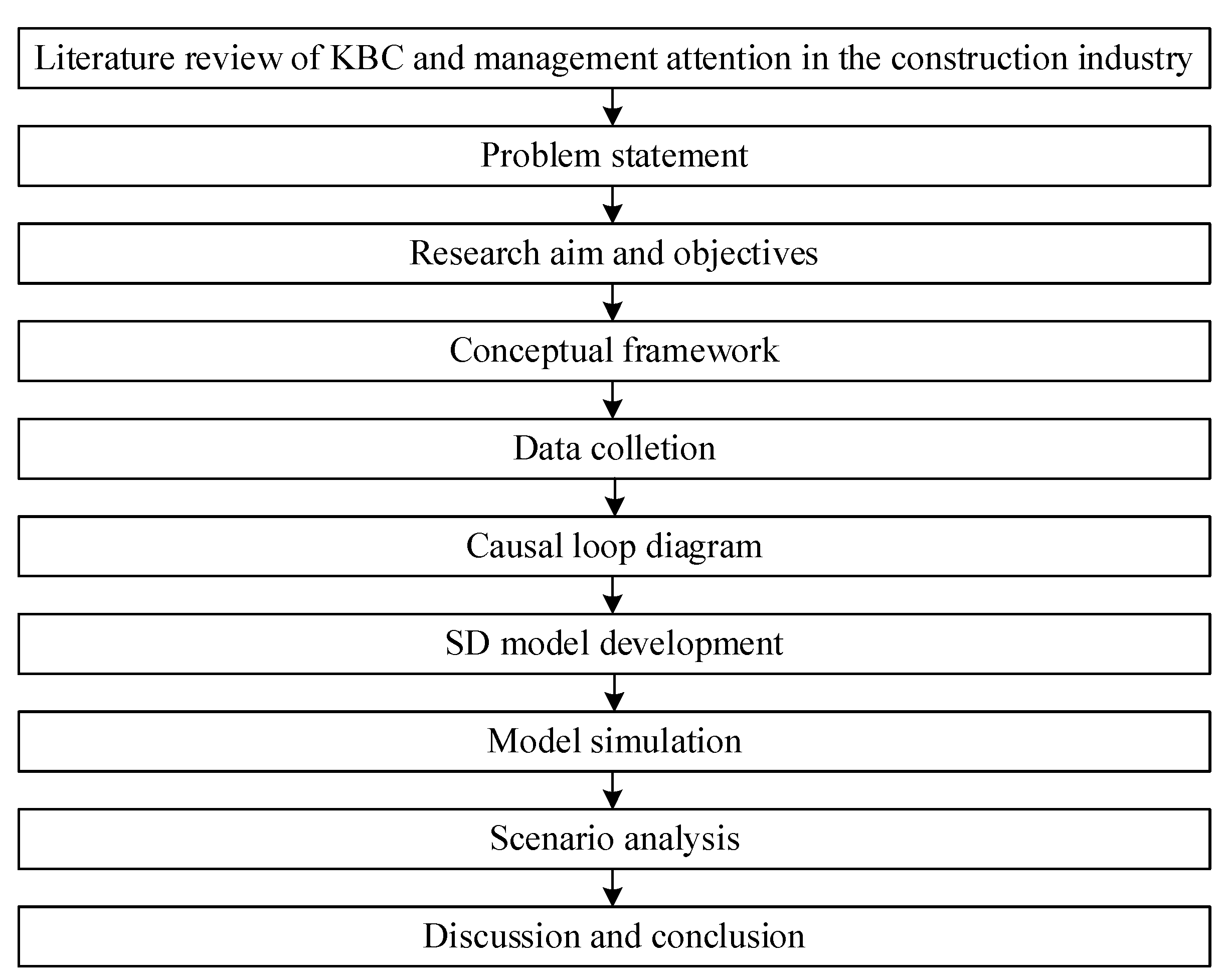
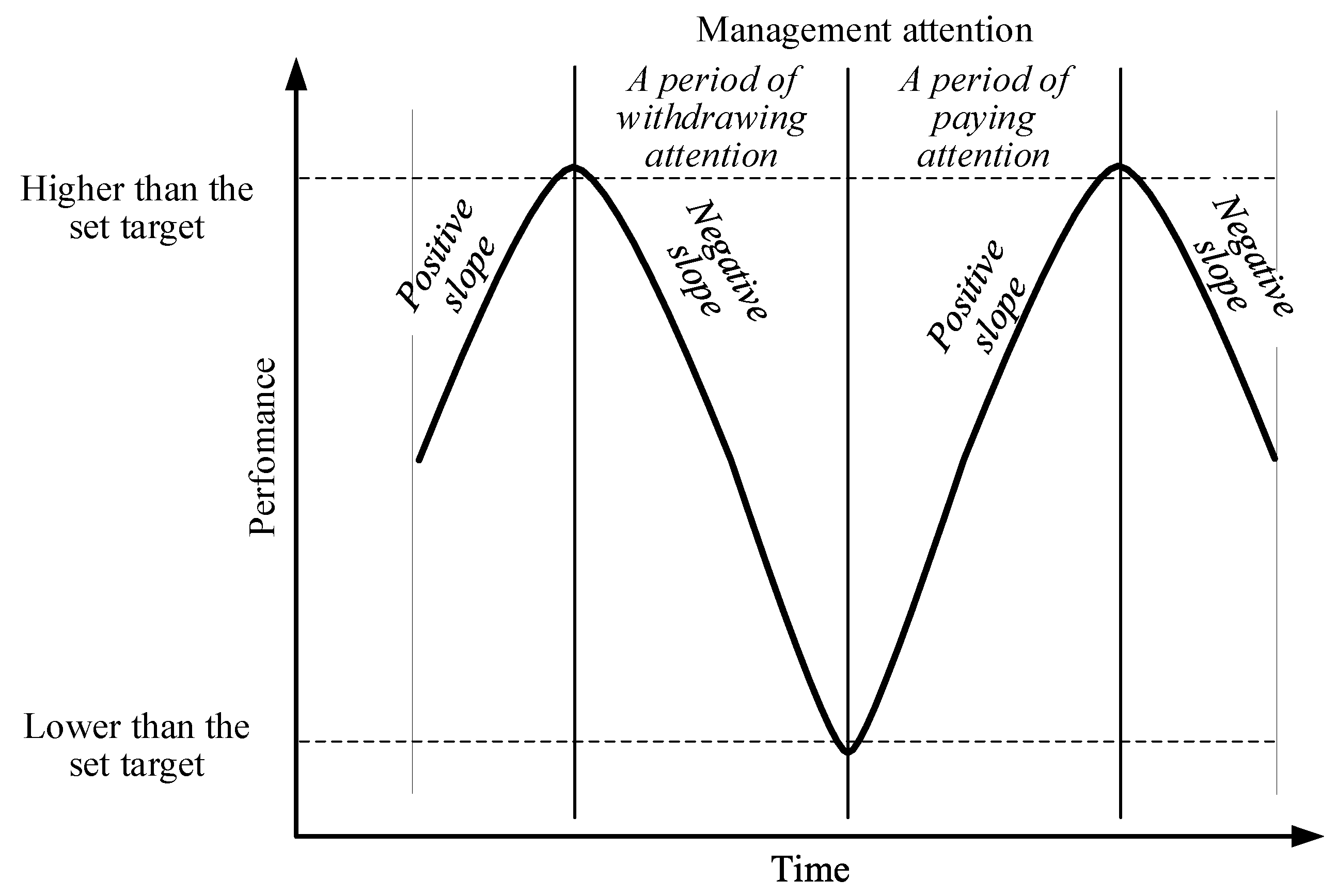
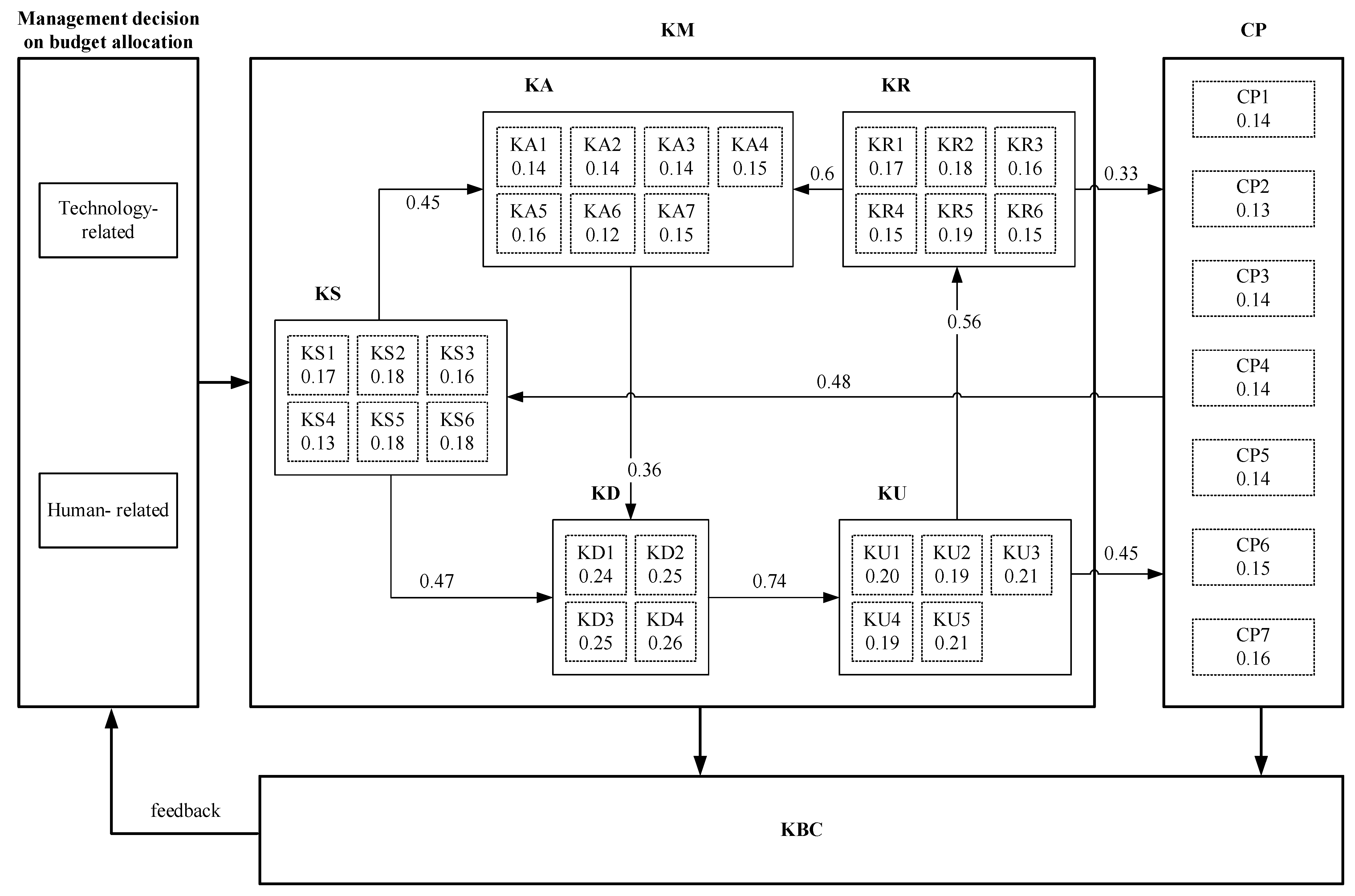
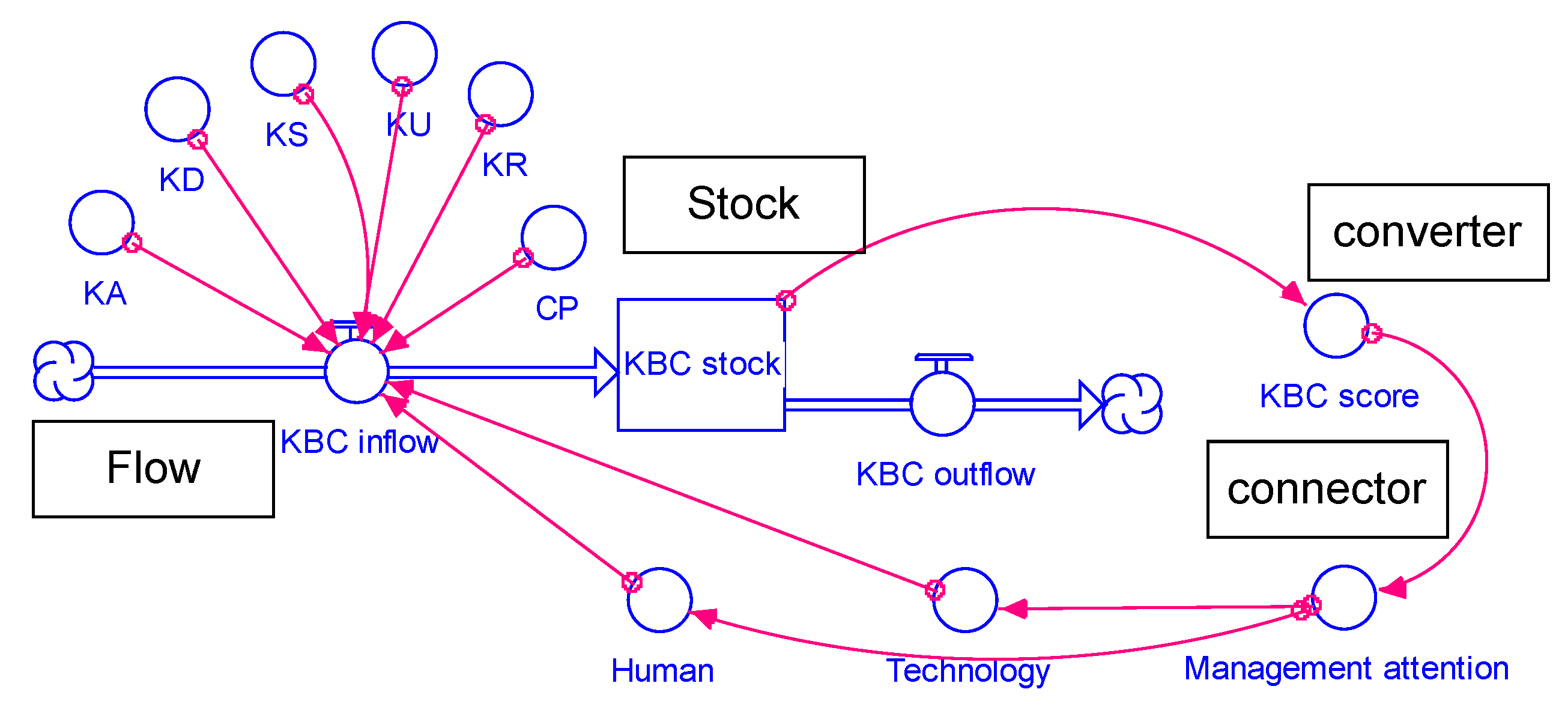




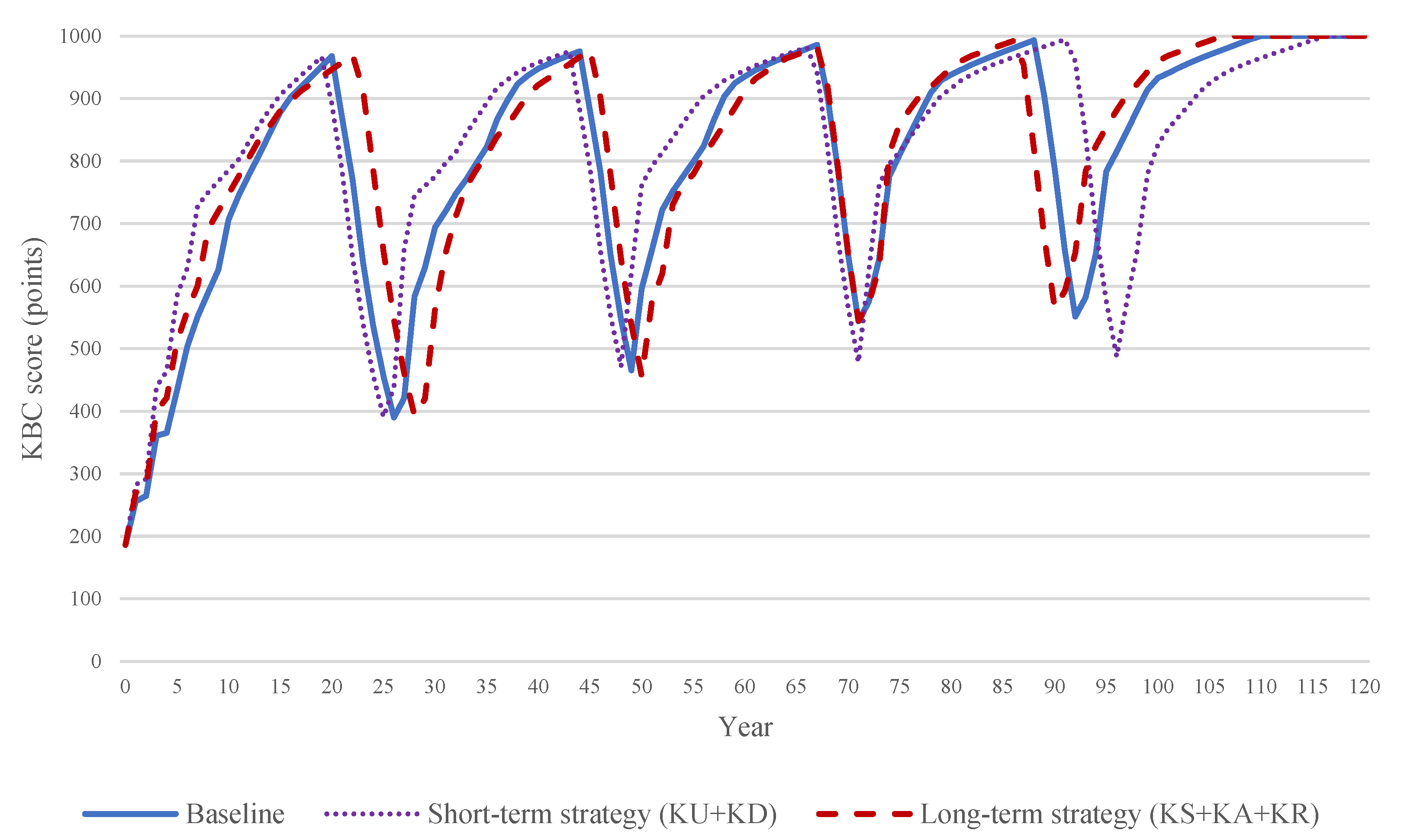
| Author | Methodology | Contribution |
|---|---|---|
| Ahmad and An [21] | Qualitative study | Developed a practical KM model focusing on the effectiveness of tacit/explicit KM. |
| Abuezhayeh [25] | Questionnaires, qualitative interviews, hypothesis testing | Proposed a conceptual framework, a tool to enable improved decision-making, for KM-BPM integration, emphasizing strategic and operational alignment. |
| Albooyeh and Yaghmaie [20] | Fuzzy analytic hierarchy process | Introduced fuzzy decision models for comparative KM evaluations across organizations. |
| Altaie and Dishar [36] | Surveys, statistical analysis | Enhanced construction project success in Iraq by improving the KM process through AI applications. |
| Chen and Fong [22] | SD modeling | Provided a comprehensive and dynamic KM evaluation framework focusing on long-term strategic alignment. |
| Debs and Hubbard [34] | Qualitative interviews, surveys | Identified gaps in knowledge capture, highlighted the need for systematic protocols and recommended improvements for reuse. |
| Eken et al. [35] | Interview with construction experts. | Introduced an effective digital tool for lessons learned management, enhancing organizational learning via technology. |
| Fong and Kwok [18] | Empirical surveys, statistical analysis | Explained how cultural type influences KM, with practical implications for fostering sharing in construction firms, increasing the chances of success. |
| Idrees et al. [24] | Survey; structural equation modeling | Quantified the impact of KM on performance and clarified the mediation role of innovation in construction organizations. |
| Jia et al. [26] | Empirical survey, component-based structural equation modeling | Provided understanding of how knowledge shared in virtual spaces could be leveraged for improving management performance in construction project teams |
| Khoa and Chinda [30] | Survey; structural equation modeling | Offered empirical evidence linking KM to competitiveness, recommended actions to enhance KM in construction, and developed a validated self-assessment tool for construction firms. |
| Kokkaew et al. [6] | Survey, structural equation modeling | Offered guidance for human resource managers in construction companies. |
| Leal, Cunha and Couto [27] | Comprehensive literature review | Guided organizations in fostering effective KS practices. |
| Mandičák, Mésároš and Tkác [38] | Case studies, surveys | Supported BIM’s strategic role in management and highlighted practical ways to enhance KM. |
| Nobert Leo Raja, Dhamodharn and Janardhanan [28] | Literature review, group interview | Proposed a model for ICT-enabled KM in project-based industries. |
| Perotti et al. [31] | Literature synthesis, conceptual analysis | Introduced the concept of knowledge sabotage. |
| Tabejamaat et al. [23] | Quantitative survey, structural equation modeling | Showed the relationships between KM infrastructure, job satisfaction, and productivity in the construction industry. |
| Wang and Meng [33] | Literature review, survey | Provided a framework for integrating BIM into KM in construction. |
| Wang et al. [29] | Quantitative survey, structural equation modeling | Linked social structures with KM and innovation. |
| Yan et al. [37] | Systematic literature review, content analysis, bibliometric mapping | Identified research gaps and suggested future directions to enhance KM. |
| Yap and Lock [32] | Questionnaire survey, statistical analysis | Highlighted the importance of soft factors in KM and provided policy recommendations for SMEs. |
| Budget Perspective | Factor | Associated Item | Total Score | ||||
|---|---|---|---|---|---|---|---|
| Name | Maximum Score | Name | Definition | Initial Score | Maximum Score | ||
| Technology-related | KS | 241 | KS1 | Accessing the control system | 5.9 | 41.0 | 241 |
| KS2 | Automating data validation | 6.2 | 43.4 | ||||
| KS3 | Applying a data warehouse platform | 5.6 | 38.6 | ||||
| KS4 | Digitally archiving system | 4.6 | 31.3 | ||||
| KS5 | Storing lessons learned in a database | 6.2 | 43.4 | ||||
| KS6 | Having an automated storage workflow | 6.2 | 43.4 | ||||
| Human-related | KA | 101 | KA1 | Gathering client insights through direct feedback and interactions | 2.7 | 14.1 | 539 |
| KA2 | Collecting market intelligence from competitors via observation and analysis | 2.7 | 14.1 | ||||
| KA3 | Learning from employee performance reviews and KPI evaluations | 2.7 | 14.1 | ||||
| KA4 | Interpreting financial reports to inform managerial decision-making | 2.9 | 15.2 | ||||
| KA5 | Conducting market research using interviews, surveys, and fieldwork | 3.1 | 16.2 | ||||
| KA6 | Sharing printed knowledge materials with project teams and stakeholders | 2.4 | 12.1 | ||||
| KA7 | Applying industry benchmarking results through collaborative discussion and analysis | 2.9 | 15.2 | ||||
| KD | 180 | KD1 | Facilitating interactive dialogue and feedback sessions between teams | 8.9 | 43.2 | ||
| KD2 | Conducting one-on-one mentorship and knowledge transfer programs | 9.4 | 45.0 | ||||
| KD3 | Sharing product and process insights through team workshops and training | 9.4 | 45.0 | ||||
| KD4 | Coordinating cross-departmental meetings for market trend updates | 9.8 | 46.8 | ||||
| KR | 126 | KR1 | Adapting services based on client feedback and requirements | 4.4 | 21.4 | ||
| KR2 | Addressing client concerns during technological transitions | 4.7 | 22.7 | ||||
| KR3 | Developing strategic responses to competitive market actions | 4.2 | 20.2 | ||||
| KR4 | Implementing solutions based on employee feedback and suggestions | 3.9 | 18.9 | ||||
| KR5 | Adjusting business strategies to align with market development | 4.9 | 23.9 | ||||
| KR6 | Applying lessons learned from past project experiences | 3.9 | 18.9 | ||||
| KU | 132 | KU1 | Implementing process improvement based on organizational experience | 5.6 | 26.4 | ||
| KU2 | Developing competitive strategies through market insights | 5.2 | 25.1 | ||||
| KU3 | Guiding strategic planning with collective organizational wisdom | 5.8 | 27.7 | ||||
| KU4 | Applying team expertise to resolve operational challenges | 5.2 | 25.1 | ||||
| KU5 | Enhancing business operations through best practices | 5.8 | 27.7 | ||||
| - | CP | 220 | CP1 | Time | 5.7 | 30.8 | 220 |
| CP2 | Cost | 5.4 | 28.6 | ||||
| CP3 | Quality | 5.7 | 30.8 | ||||
| CP4 | Productivity | 5.7 | 30.8 | ||||
| CP5 | Employee’s satisfaction | 5.7 | 30.8 | ||||
| CP6 | Client’s satisfaction | 6.2 | 33.0 | ||||
| CP7 | Innovation | 6.6 | 35.2 | ||||
| Total KBC score | 186.2 | 1000 | 1000 | ||||
Disclaimer/Publisher’s Note: The statements, opinions and data contained in all publications are solely those of the individual author(s) and contributor(s) and not of MDPI and/or the editor(s). MDPI and/or the editor(s) disclaim responsibility for any injury to people or property resulting from any ideas, methods, instructions or products referred to in the content. |
© 2025 by the authors. Licensee MDPI, Basel, Switzerland. This article is an open access article distributed under the terms and conditions of the Creative Commons Attribution (CC BY) license (https://creativecommons.org/licenses/by/4.0/).
Share and Cite
Khoa, V.D.; Chinda, T. Dynamic Effects of Management Support on Knowledge-Based Competitiveness in Construction Companies. Buildings 2025, 15, 2015. https://doi.org/10.3390/buildings15122015
Khoa VD, Chinda T. Dynamic Effects of Management Support on Knowledge-Based Competitiveness in Construction Companies. Buildings. 2025; 15(12):2015. https://doi.org/10.3390/buildings15122015
Chicago/Turabian StyleKhoa, Vo Dang, and Thanwadee Chinda. 2025. "Dynamic Effects of Management Support on Knowledge-Based Competitiveness in Construction Companies" Buildings 15, no. 12: 2015. https://doi.org/10.3390/buildings15122015
APA StyleKhoa, V. D., & Chinda, T. (2025). Dynamic Effects of Management Support on Knowledge-Based Competitiveness in Construction Companies. Buildings, 15(12), 2015. https://doi.org/10.3390/buildings15122015







